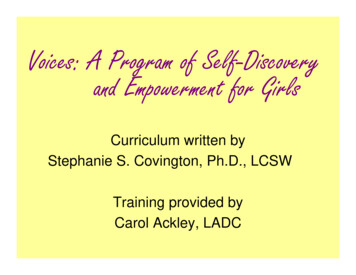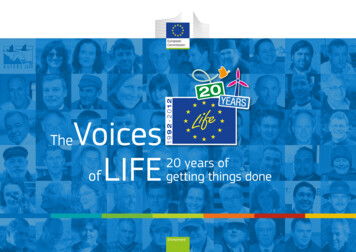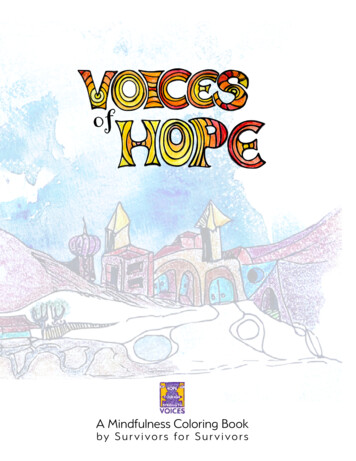
Transcription
Voices: A Program of Self-Discoveryand Empowerment for GirlsCurriculum written byStephanie S. Covington, Ph.D., LCSWTraining provided byCarol Ackley, LADC
Definition of Gender-ResponsivenessCreating an environment through siteselection, staff selection, programdevelopment, content, and materialthat reflects an understanding of therealities of women’s and girls’ lives,and is responsive to their strengthsand challenges.(Covington & Bloom)
Gender-Responsive: Guiding Principles Gender Environment Relationships Services Economic & Social Status Community
Guiding Principles Gender: Acknowledge that gender makes adifference. Environment: Create an environment basedon safety, respect, and dignity.
Guiding Principles (cont.) Relationships: Develop policies, practices,and programs that are relational andpromote healthy connections to children,family, significant others, and thecommunity. Services: Address substance abuse,trauma, and mental health issues throughcomprehensive, integrated, and culturallyrelevant services.
Guiding Principles (cont.) Socioeconomic status: Provide girls/womenwith opportunities to improve their socioeconomic conditions. Community: Establish a system ofcomprehensive and collaborative communityservices.(Bloom, Owen, Covington 2003)
Therapeutic Environment Attachment: a culture of belonging Containment: a culture of safety Communication: a culture of openness Involvement: a culture of participationand citizenship Agency: a culture of empowerment(Haigh)
Sanctuary
Definition of Sanctuary Sacred place Place of refuge/protection Shelter
Qualities of a FacilitatorThe following qualities in a facilitator will helpto ensure a positive group experience: Trustworthiness Reliability, consistency Warmth, compassion Emotionally mature
Qualities of a Facilitator (cont.) Healthy boundaries, respect for confidentiality Committed to and interested in the girls’ issues Multi-cultural sensitivity and responsiveness
Qualities of a Facilitator (cont.) Appropriate gender (a female should facilitatethe all-female groups) Content expertise, if possible Facilitation Skills
Qualities of a Facilitator (cont.) BEPREPARED!
Four Key Elements in theVoices Group Process1.Understanding more about their experiencesas girls– their similarities to and differencesfrom others in the group2.Exploring how the influences in their lives(e.g., gender, families, substance abuse,interpersonal violence and various forms ofoppression) have impacted them
Four Key Elements in theVoices Group Process (cont.)3.Learning skills and coping mechanisms tohelp them both now and in the future4.Feeling safe and learning that this is a safeplace to share their voices
VoicesFour ModulesSelf Connecting with Others Healthy Living The Journey Ahead
What about the Girls?
Reality of Girls’ Lives Socialization and identity Culture and class Sexuality Violence and aggression Expressions of risk
Socialization and Identity Girls stop “being” and start “seeming”. Girls develop identity in theirconnections with others.
Culture and Class Ethnicity and socioeconomic statushave a significant impact on girls’strengths and challenges.
Sexuality 50% 9-12th graders havehad intercourse.(Centers for Disease Control, 2002) 74% of young women who hadintercourse before age 14 and 60%before age 15 reported it was involuntary.(Planned Parenthood Federation of America, 2001)
Sexuality (cont.) 24.5% of sexually active 9th grade girlsuse alcohol/drugs with intercourse.(Center for Disease Control, 2002) 4 out of every 10 young women arepregnant before age 20.(The National Campaign to Prevent Teen Pregnancy, 2001) Teenage sex often means girls servicingboys.(Denizet-Lewis, 2004)
Sexually Transmitted Infections(STIs)STIs may result from the sexual transmission of bacterialor viral agents such as:Chlamydia trachomatis (Chlamydia)Neisseria gonorrhoeae (Gonorrhea)Treponema pallidum (Syphilis)Trichomonas vaginalis (Trichomonas)Human Immunodeficiency Virus (HIV)
Chlamydia and Gonorrhea Highest rates among adolescents and youngadults (34% of infections are 10-19 year olds[CDC, 2004]). Higher rates in youth involved juvenile justicesystems 70% of infections do not have symptoms Major cause of reproductive health consequencesin females (e.g. PID, epididymitis). Current STI 3-5 times more likely to contract HIV Effectively treated with antibiotics(Source: Department of Criminal Justice, Temple University)
Among Young Attendees at STD Clinics,Substance Abusers Reportmore Risky BehaviorAlways UsedCondomsPercentage of Patients90%80%Mutiple SexPartners70%STD Diagnosed60%48.8%50%40%30%20%35.00%28.8% 26.70%14.4%10%6.1%0%No SUDWith SUDPatients aged 15 to 24 of a public sexuallytransmitted disease clinic who had asubstance use disorder (SUD) were two tothree times likely as those without an SUDto report multiple sex partners andinconsistent condom use during the pastyear. Overall, 43 percent of the 448patientswhoparticipatedinthePittsburgh, clinic study had an alcohol ormarijuana use disorder, and these youngpeople also were 70 % more likely to bediagnosed with a sexually transmitteddisease during their visit.Source: Cook R.L., et al. Alcohol and drug use related disorders: Anunderrecognized health issue among adolescents and young adultsattending sexually transmitted disease clinics. Sexually TransmittedDiseases 33(9): 565-570, 2006.
Violence & Aggression Violent crime doubled from 1988 – 1994.(Mahan, 2003) Girl initiated violence increased 118%since 1987.(Brown, 2002) Girl fighting – horizontal hostility(Brown, 2002)
Expressions of Risk Depression Substance abuse Relationship violence Eating disorders Teen mothers Girls in juvenile justice settings
Girls’ Mental Health Needs Girls who are coping with such seriousissues as sexual abuse, substanceabuse, family dysfunction and/oracademic failure may experiencedepression, eating disorders, and othermental health concerns. More than half of young women intraining schools have reportedattempting suicide; of those, 64% havetried more than once to kill themselves.
Substance AbuseGirls use alcohol and other drugs to: Improve mood Reduce tension Increase confidence Lose inhibitions Exchange sex Lose weight
Adolescence & Alcohol Start drinking before age 1447% alcohol dependent Start drinking after age 219% alcohol dependent(n 43,000)(Source: Archives of Pediatrics & Adolescent Medicine, July 2006)
Alcohol & Adolescent Brain Disrupts parts of the brain essential forself-control, motivation and goal-setting More severe damage in adolescent brainthan adult brain(University of North Carolina; Duke; UCSD)
Alcohol & Adolescent Brain (cont.) Adolescent brain is more vulnerable andmore resilient with sobriety.(UCSD)
Relationship Violence Girls risk three times greater than boys.(Banister & Screiber, 2001) Homicide (by someone they know) is aleading cause of girls’ death.(Anderson, 2002) 1 in 5 girls abused by dating partner.(Patton & Morgan, 2002)
Sexual Assault GraphBureau of Justice Statistics, 2000
Sexual Assault GraphBureau of Justice Statistics, 2000
Female Delinquents and Sexual Abuse Among female delinquents, an estimated70% have a history of sex abuse. In some detention facilities, the incidenceof girls who have been abused is closer to90%. Most often, abuse is perpetrated by familymembers or close family friends who areperceived as trusted adults.
Effects of Abuse on GirlsSexual abuse can have a profoundimpact on a girl during adolescence: lessened self-esteeminability to trustacademic failureeating disordersself-harmteen pregnancyrunning awaysubstance abusedefensive & reactive violence
Eating Disorders7 million women 43% onset 16 – 20 33% onset 11 – 15 10% onset 10 and under(National Association of Anorexia Nervosaand Associated Disorders, 2004)
Girls in Juvenile Justice Settings Histories of victimization Unstable family lives School failure Repeated status offenses Mental health problems Substance abuse
A High-Risk Population 1.4 M adolescents incarcerated in 2004 (USDOJ,2004) Engage in high-risk behaviorsSubstance use: 75% drug of alcohol (Belenko & Logan, 2003)Early sexual initiation (Teplin et al., 2003)Multiple partners (Teplin et. Al, 2003)Unprotected sex (Canterbury et al., 1995) Substance use associated with higher STI risk(Cook, 2006) Limited access to health care, STIeducation/prevention (Forrest et al., 2000)
Girls and Juvenile Justice Between 1980 and 2000, the juvenilearrest rate for girls increased 35%.(Snyder, 2002) In 2000, girls accounted for 28% of alljuvenile arrests compared with 19% in1990.(Maniglia, 1998; Snyder, 2002) From 1991 to 2000, the juvenile arrest ratefor aggravated assault increased by 44%for girls and declined 16% for boys.(Snyder, 2002).
Girls and Juvenile Justice (cont.) Approximately 78% of arrests of girls forcrime index offences are not for violence,but for larceny-theft, or shoplifting.(FBI, 2000). Girls account for 59% of arrests for runningaway and 55% of arrests for prostitution.(Snyder, 2002) Between 1988 and 1997, the use of detentionfor girls increased 65% as compared with a30% increase for boys.
Poor Academic Performance One significant risk factor relating toearly onset of delinquency is pooracademic performance. By the time girls enter the system, theymay be at least a grade level behindtheir peers. Girls may have developed a negativeattitude about learning and lack selfconfidence about their own ability tomaster academic skills.
Risk & Protective FactorsRisk Factors History of sexual abuseAcademic failureSubstance abuseLow self-esteemFragmented familyLack of trusting adultRacismSexismNegative peer groupLack of safe, nurturingenvironmentProtective Factors Positive sexual development Academic success/progress Positive self-esteem Positive, nurturing family Positive cultural and genderidentity Positive peer group Positive relationship withcaring adult Safe, nurturing environment
Protective Factors Easier to Changethan Risk DAG, 2004)
Why Develop Gender-Responsive Programs? Girls travel a different path to problemsthan most of their male counterparts. After years of struggling to squeeze girlsinto programs designed for boys, someagencies that work with girls are seekingapproaches that are gender-specific.
Gender-Responsive Programs This does not mean giving girls thesame programs as boys, or simplyisolating juvenile offendersaccording to gender. Instead, the most effectiveprograms are rooted in theexperience of girls and incorporatean understanding of femaledevelopment.
How do We Develop Services for Girls?
Definition of Gender-ResponsivenessCreating an environment through siteselection, staff selection, programdevelopment, content, and material thatreflects an understanding of the realitiesof women’s and girls’ lives, and isresponsive to their strengths andchallenges.(Covington & Bloom)
Creating Programs for GirlsGender-Responsive Elements Celebrates Strengths Safety is Key Female Mentors and Role Models Develop and Support Leadership Skills Empower Girls – Force for Social Change Media Literacy Physical, Sexual and Mental Health Information Cultural Connections Solidarity between Girls and Women
Theoretical FrameworkThe theories related to gender andsubstance abuse (and any other relevanttreatment services) that create theframework of thought for programdevelopment. This is the knowledge basethat creates the foundation upon which theprogram is developed.
Treatment StrategiesThe approaches used in the program thatcreate the therapeutic process. These arethe ways in which theory is operationalized(how theory is applied).
Concepts of Successful InterventionsStrength-based approach: Workingfrom a positive perspective, buildingon girls’ personal and culturalstrengths and providing opportunitiesfor girls to be successful.
Addressing the “Whole Girl”Domains: Physical Sexual Relationships Emotional Intellectual Spiritual
Voices: A Program of Self-Discoveryand Empowerment for GirlsTheoretical Foundation Psychological development Attachment Resilience Addiction Trauma
Psychological DevelopmentRelational Theory Gilligan Stone Center Brown
Growth Fostering Relationships Increased zest and vitality Empowerment to act Knowledge of self and others Sense of self-worth Desire for more connections
Alone and Lonely Girls are alone more than 20% of awake time Less than 10% of time outside school withfriends-happiest then 12th graders have 50% more alone time than6th graders Many girls alone over 6 hrs a day Too much solitude poor outcomes(Source: M. Strauss, All the Rage)
Attachment Theory Bowlby Harlow Winnecott Stern Ainsworth
Types of Attachment Secure Avoidant Ambivalent (or anxious-avoidant)
Resilience Close relationship with one adult High expectations from significant people Positive role models and community involvement
very(expansion)
Definition of TraumaThe diagnostic manual used by mental health providers(DSM IV-TR) defines trauma as, “involving direct personalexperience of an event that involves actual or threateneddeath or serious injury, or other threat to one’s physicalintegrity; or a threat to the physical integrity of anotherperson; or learning about unexpected or violent death,serious harm, or threat of death or injury experienced by afamily member or other close associate.”“The person’s response to the event must involve intensefear, helplessness or horror (or in children, the responsemust involve disorganized or agitated behavior).”
TraumaSexual abusePhysical abuseEmotional abuseDomestic violenceWitnessing abuse/violenceSelf-inflicted violence
Trauma (cont.)StigmatizationGirls in juvenile justice systemGirls of colorPoor girlsLesbian, transgendered, bisexualGirls with mental illness
PTSD Nightmares; Flashbacks Estrangement Numbing of General Responsiveness Insomnia Exaggerated Startle Response Hypervigilance(DSM-IVTR)
Co-occurring DisordersThere is a high level of co-morbidity between posttraumatic stress disorder and:DepressionAnxietyPanic disorderPhobic disorderSubstance abusePhysical disordersSource: “Gender-Responsive Strategies: Research, Practice and GuidingPrinciples for Women Offenders Project: Covington & Bloom (2001)
Trauma ServicesTrauma-informedThese are services that are providedfor problems other than trauma butrequire knowledge about violenceagainst girls and women and theimpact of trauma; thereby increasingtheir effectiveness.
Ten Principles ofTrauma-Informed ServicesPrinciple 1.Trauma-Informed Services Recognize theImpact of Violence and Victimization onDevelopment and Coping Strategies
Ten Principles ofTrauma-Informed Services (cont.)Principle 2.Trauma-Informed Services Identify Recoveryfrom Trauma as a Primary Goal
Ten Principles ofTrauma-Informed Services (cont.)Principle 3.Trauma-Informed Services Employ anEmpowerment Model
Ten Principles ofTrauma-Informed Services (cont.)Principle 4.Trauma-Informed Services Strive to Maximize aWoman’s/Girl’s Choices and Control Over HerRecovery
Ten Principles ofTrauma-Informed Services (cont.)Principle 5.Trauma-Informed Services Are Based in aRelational Collaboration
Ten Principles ofTrauma-Informed Services (cont.)Principle 6.Trauma-Informed Services Create anAtmosphere That Is Respectful of Survivor’sNeed for Safety, Respect, and Acceptance
Ten Principles ofTrauma-Informed Services (cont.)Principle 7.Trauma-Informed Services EmphasizeWomen’s/Girls’ Strengths, HighlightingAdaptation Over Symptoms and ResilienceOver Pathology
Ten Principles ofTrauma-Informed Services (cont.)Principle 8.The Goal of Trauma-Informed Services Is toMinimize the Possibilities of Retraumatization
Ten Principles ofTrauma-Informed Services (cont.)Principle 9.Trauma-Informed Services Strive to Be CulturallyCompetent and to Understand Each Woman/Girlin the Context of Her Life Experiences andCultural Background
Ten Principles ofTrauma-Informed Services (cont.)Principle 10.Trauma-Informed Agencies Solicit ConsumerInput and Invoice Consumers in Designing andEvaluating ServicesElliot, D.E.; Bjelajac, P.; Fallot, R.D.; Markoff, L.S.; Reed, B.G. Trauma-Informed orTrauma-Denied: Principles and Implementation of Trauma-Informed Services forWomen. Journal of Community Psychology, July, 2005., 33(4): 461-477.
ACE Study(Adverse Childhood Experiences) Recurrent and severe emotional abuse Recurrent and severe physical abuse Contact sexual abuseGrowing up in a household with: An alcoholic or drug-user A member being imprisoned A mentally ill, chronically depressed, orinstitutionalized member The mother being treated violently Both biological parents not being present(N 17,000)
ACE Study(Adverse Childhood Experiences)ResultsACEs still have a profound effect 50 years later,although now transformed from psychosocialexperience into organic disease, socialmalfunction, and mental illness.– Smoking– Alcoholism– Injection of illegal drugs– Obesity(Felitti, V.J.: Origins of Addictive Behavior: Evidence from the ACE Study. 2003 Oct:52(8):547-59. German. PMID: 14619682 (PubMed-indexed for MEDLINE).
Childhood Traumatic EventsLargest Effect-Mental Health Psychotropic medication Mental health treatment Attempted suicide Traumatic stress(Messina & Grella, 2005)
Childhood Traumatic EventsLargest Effect-Mental Health 980% increase in odds if exposure to 7CTE’s(Messina & Grella, 2005)
Process of TraumaTRAUMATIC EVENTOverwhelms the Physical & Psychological SystemsIntense Fear, Helplessness or HorrorRESPONSE TO TRAUMAFight or Flight, Freeze, Altered State of Consciousness, Body Sensations, Numbing, Hyper-vigilance,Hyper-arousalSENSITIZED NERVOUS SYSTEMCHANGES IN BRAINCURRENT STRESSReminders of Trauma, Life Events, LifestylePAINFUL EMOTIONAL STATERETREATSELF-DESTRUCTIVE ACTIONDESTRUCTIVE NCE ABUSEEATING DISORDERDELIBERATESELF-HARMSUICIDAL ACTIONSAGGRESSIONVIOLENCERAGES
Self-Harm Interventions Validate realityUnderstand cycle (CBT frame)Know when she doesn’t self-harmHarm reductionTry other things first (writing) Therapy for feelings and thoughts Teach new methods of coping: findingwords and someone to hear them(Source: Tracy Alderman, Scarred Souls)
VoicesFour ModulesSelf Connecting with Others Healthy Living The Journey Ahead
Each Session Contains theFollowing Components:Opening: Helping girls check-in/become presentTeaching: Key topic is presentedInteractive: Discussion of issues, questions, etc.Experiential: Exercises to try out new skills andlearningClosure:Focus questions to facilitate reflection
SELFModule A:Self
Module A: SelfSession 1Session 2Session 3Session 4Session 5Who am I?My Life StoryBreaking the SilenceThe World Girls Live InSupport and Inspiration(27 activities)
Who am I?Describing myself A feeling A belief A quality
Examples of Feelings Joyful Content Bitter Sad Relaxed Furious Angry Jealous Depressed Happy Calm Ashamed Afraid Anxious Embarrassed
Examples of Beliefs I believe in myselfI believe it’s okay to be a virginI believe in equalityI believe you are what you eatI believe that life is toughI believe in practicing safer sexI believe that I can trust my friendsI believe that I am fun, clean and soberI believe that I can use my voiceI believe I am a good listenerI believe that I have rightsI believe that I can meet my goals
Examples of Qualities I am strongI am a good friendI don’t trust people easilyI am curious about thingsI am smartI am a lonerI am sexyI do well in schoolI am honestI am caringI am funnyI am a good artist
Feeling Okay Chart
Five Senses Activity5 things you can see4 things you can touch3 things you can hear2 things you can smell1 thing you can taste
My Life’s Journey
Tree of Self Esteem
Esteemable ActsOne way to improve your self-esteem is to dothings that make you feel good about yourself.What three things can you do?1.2.3.(Source: F. Ward)
Me: Inside and Out
Got Power?
Media MessagesKey points to convey: Media messages are everywhere (e.g., in music,television, movies and advertising). Media messages give limited and unrealisticportraits of women and girls. Media messages tell us that alcohol and cigarettescan make us sexier, attractive, desirable and fun.Media messages do not show us the negativeconsequences of substance use and abuse (e.g.,getting sick, being addicted). Media messages can make us feel bad about whowe are.
Break the Chain!
What I have Learned from Her
What I have Learned from HerName:She has inspired me by:
OTHERSModule B:Connecting with Others
Module B: Connecting with OthersSession 6Session 7Session 8Session 9Session 10Session 11Session 12CommunicationMy FamilyMothers and DaughtersFriendshipDating and SexualitySupportive RelationshipsAbuse Relationships(36 activities)
Communication is:An exchange of ideas; anexpression of oneself in such a waythat one is clearly understood; aconnection, one with another.
Communication (cont.) Passive communication Aggressive Passive-aggressive Assertive
My FamilyMeKeyStrong--------Weak--------Broken/no connectionConfusingAngry
Healthy Families
Mom and MeKey Points: Mother-daughter relationships arecomplex and powerful. Our mothers influence how we seeourselves as young women. Mothers are more than simply theirroles. It can be interesting andenriching to get to know our mothersas complete persons.
FriendshipKey Points: It is important to think critically about why girlscan be mean to one another. Girls’ relationships with one another are veryimportant parts of their lives. Collaborating with and supporting oneanother counteracts negative stereotypes offemales and creates powerful, collectiveopportunities for change in girls’ lives.
Is it Love? Infatuation: Intense feeling of attraction to, admiration foror fascination with another person that may not be basedon realistic facts or a true understanding of or connectionwith the person. Often does not involve seeing theperson realistically. Can feel “high” and exciting. Sexual attraction: A desire or longing to be involved withsomeone physically and sexually. Love: A deep, tender feeling of affection and care towardanother person. Can involve sexual attraction or intimacybut is much broader in that it also involves a sense ofoneness, understanding, trust, respect and care. Love isalso a behavior.
Shades of Sexuality Gender Gender identity Sexual orientation Straight Gay/lesbian Bisexual
Sexual Bill of RightsMy Sexual Bill of RightsIto .thgirehave th
Connecting with Others
A Map of My Relationships
What is Abuse? Emotional Physical Sexual
Effects of AbuseKey Points: Abuse can have a long-term impact on the victim. A girl’s reaction to abuse can take many forms. You are not alone if you are the victim of abuse. There are things you can do to heal from abuse. There are people and organizations that workvery hard to end abuse.
Power and Control Wheel
HEALTHModule C:Healthy Living
Module C: Healthy LivingSession 13Session 14Session 15Session 16Our BodiesEmotional WellnessAlcohol and Other DrugsSpirituality(24 activities)
My Body Image
Five Steps to Emotional Wellness1. Tune in to feelings.2. Name the feeling.3. Locate the feeling in your body.4. Express the feeling.5. Practice containment – which meansholding your feelings in order to shareand process them in a safe place witha trusted person.
Containing vs. Stuffing1. Slow down or stop what you’re doing.2. Identify what you’re feeling.3. Name the feeling.4. Notice where you feel it in your body.5. Evaluate whether the intensity of thefeeling matches the situation.6. Consider what other factors may becontributing to your intense feeling.
Anger and MeKey Points: Young women are encouraged/socializedto be nice. When girls don’t feel that they canexpress anger, they are unable to be theirtrue, authentic selves. It is important to learn how to expressanger. Anger is a healthy reaction to injustice,racism and poverty.
Assessing Anger Who else is she angry at?How is her behavior effective?How has she attempted to express it in the past?What was the response?When did she start? Is it same?What is happening to make her mad?(Source: M. Strauss, All the Rage)
Assessing Anger What else is she feeling?What would she like to have happen?What IS going to happen?How effective is the communication?Will she need to escalate, suffer more to getwhat she needs?(Source: M. Strauss, All the Rage)
Weighing it Out
Understanding Addiction Biological Psychological Environmental
SpiritualityIncludes but not limited to: Quiet time Prayer Meditation Centering activities, such as singing orlistening to music Being out in nature Creating personal altars (a collection ofpersonal items that mean a lot to you)
Spirituality (cont.) Attending church, synagogue, mosque, temple or another spiritual meeting placeKeeping a journalHelping others in needLearning from othersCelebrationsWise womanCultural ritualsAppreciation and gratitude
JOURNEYModule D:Journey Ahead
Module D: Journey AheadSession 17Session 18CrossroadsPacking for My Journey(9 activities)
Crossroads
My CrossroadsHow might choosing this pathaffect you in the short-term?How might choosing this pathaffect you in the short-term?How might choosing this pathaffect you in the long term?How might choosing this pathaffect you in the long term?
Making Good Decisions for Me
My Group ive
Sisterhood and Support
For More Information Stephanie S Covington, Ph.D, LCSWEmail: SC@stephaniecovington.comWebsites: stice.org Carol Ackley, LADCEmail: Ackley@riverridgetreatmentcenter.com
Positive self-esteem Positive, nurturing family Positive cultural and gender identity Positive peer group Positive relationship with caring adult Safe, nurturing environment. Protective Factors Easier to Change than Risk Fa










